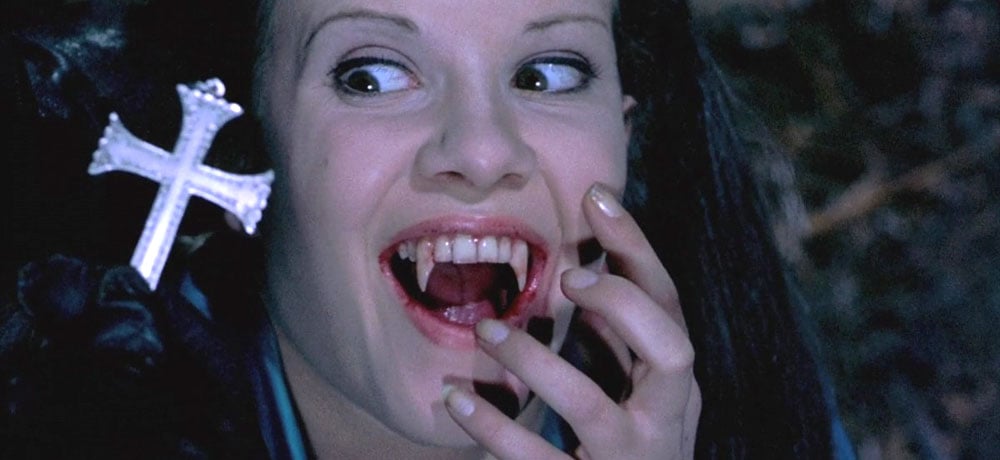


You got witch-hunting in my vampirism! Yeah? Well, you got vampirism in my witch-hunting! Deliciously combined, Hammer’s Twins of Evil (1971) pits religious fanaticism against vampiric seduction in the third and final film of the Karnstein trilogy, and it’s a fittingly erotic and spirited sendoff.
Released by Rank Film Distributors in the U.K. and Universal Pictures stateside, Twins of Evil was part of a double bill with Hands of the Ripper (also ’71, but the pairing didn’t make its way to the U.S.), and as these things do, brought in the casual viewer looking for a little mayhem to tide them over. Twins of Evil however, still manages to seduce the viewer through muscular filmmaking and solid performances, with the biggest draw being the stunning Collinson sisters, Mary and Madeleine, as our titular characters. They make it one of the most lascivious of the latter day Hammer films; no small feat, that.
We open on Central Europe in the late 1600s as a young woman (Judy Matheson – Crucible of Terror) is abducted from her woodland home by The Brotherhood, a group of puritanical Catholic horsemen on the hunt for witches. Led by Gustav Weil (Peter Cushing – The Uncanny), The Bros determine she’s a witch and burn her at the stake. Enter Gustav’s nieces, Maria (Mary) and Frieda (Madeleine), who have come to live with him after the sudden death of their parents. Maria is content and demure, and willing to go along with her uncle’s iron clad appropriation of parenting; Frieda, on the other hand, is carefree and looking for excitement.
Perhaps she can find it in the castle of Count Karnstein (Damien Thomas – Shogun), a man of many tastes, all of them lewd and evil; when he isn’t busy bedding the lovely women of Karnstein Village, he’s trying to live up to the Satanic rites passed down through his heritage. He finally manages to awaken Countess Mircalla (Katya Wyeth – A Clockwork Orange) after he sacrifices yet another young lass, and she rewards Karnstein by turning him into a vampire like herself. Once turned, Karnstein sets his sights on the naughty Frieda, who is more than willing to forsake the human realm for more exotic pastures. Gustav’s focus changes from witches to vampires with a lot of convincing from teacher Anton (David Warbeck – The Beyond). But will he be too late to save his nieces from the grasp of Karnstein?
Twins of Evil is a mélange, a bouillabaisse, a veritable potpourri of then current filmic trends (witchcraft) and the recently passé (vampires) – and it works surprisingly well. Well enough, anyway; neither side really has a chance to explore their mythologies, with the witch hunt business taking a backseat once the vampires rise. By the same token, the vampire lore is given truncated thrift, with sunlight being fine and dandy and transformations happening instantaneously on first bite.
But I’m not a professor in Bloodsuckerology, I’m just a guy who digs horror films, and as long as crosses, decapitations, and stakes through the heart are checked off, I’m good. (The witches seem to have their bases covered; accuse, tie to a pole, fire ‘em up.) Twins of Evil isn’t about the lore, anyway, instead offering an effective takedown of pious hypocrisy and the dual nature of man, wrapped in the more risqué elements necessary for Hammer to keep apace in the market. The cleavage flows freely throughout, with Madeleine giving viewers a peek at the twins’ Playboy shoot from the previous year; as for violence, there is a great (and surprising) beheading, lots of stake skewering, and a fair amount of the red stuff. The old gives way to the new, and the hip version of Hammer plays very well against the chaste (and old fashioned) tropes of witch portrayals on film. Their crime is usually that they’re in league with the devil, but the early, still swinging ‘70s would suggest nothing more than unchecked horniness. Not that lust isn’t high on the sin list anyway, but the loosening chastity belt around Hammer’s waist meant more show, less tell.
John Hough (The Legend of Hell House), while not quite as stylish as Hammer legend Terence Fisher, is a more forceful director who seems to adapt to this new frontier of unlaced bodices and unbound gore with ease, unflinching towards the demands of the marketplace. He seems to enjoy playing with a greasier set of tools. Tudor Gates’ (Barbarella) screenplay takes many liberties (so I’m told) with Sheridan Le Fanu’s Carmilla story, much as his two previous Hammer adaptations in the Karnstein trilogy, The Vampire Lovers (’70) and Lust for a Vampire (’71) strayed from the source material. What the script does bring though is a simple morality play on two sides of the coin – two twins, one good, one evil; two antagonists, one killing in the name of religion, one killing for kicks, albeit under the tutelage of his own dark master. Perhaps the most interesting thing about Twins of Evil is the ambiguity of Cushing’s Gustav; all too eager to blindly slaughter innocents, he starts to doubt his commitment when his own nieces’ are in danger. Cushing is able to play this uncertainty with a heartbreaking earnestness that flows through the redemptive arc Gustav is given; Warbeck is the “traditional” hero, and he’s quite good as the level-headed Anton.
But the Collinson twins have to carry the film on their beautiful shoulders; and while dubbed, they are both engaging performers who make you care about their characters. (At least one of them, anyway.) Between the novelty of their casting and the grounded efforts of Cushing, Twins of Evil shows that Hammer could keep up with trends while still holding onto their storied past; a synergetic blast well in tune with its tale of witches, vampires, and the conflicted people who hunt them.
Twins of Evil is available on Blu-ray from Synapse Films.
Next: Drive-In Dust Offs: BRIDES OF BLOOD (1968)